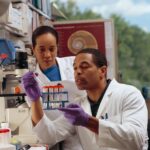Medical Laboratory Professionals Week is held annually during the last full week in April. This year it will be observed from April 19 to 25. This week highlights the vital role played by laboratory professionals in the field of medicine. The Medical Laboratory Professionals Week (M.L.P.W.) initiative, inaugurated in 1975 by the American Society for Medical Technology, now the American Society for Clinical Laboratory Science (A.S.C.L.S.), was dubbed National Medical Laboratory Week (N.M.L.W.) upon inception. The medical laboratory science field is crucial to the health care system. And although hugely unrecognized, the important work of lab professionals — testing, diagnosing, and treatment process — goes a long way in saving lives.
History of Medical Laboratory Professionals Week
Medical laboratory science has since its inception been committed to powering quality health care. One look around us today, especially with the pandemic ravaging our world since 2020, and one can’t help but feel truly grateful for the amazing work of medical laboratory professionals.
This profession has a fascinating history that dates back to the mid-1920s where we find the earliest histories of clinical laboratory sciences (C.L.S.) In the early 1900s, having a laboratory was extremely expensive, but the late 19th Century ushered in a wave of illnesses: typhoid, tuberculosis, diphtheria, etc., which called for patients to be tested and cured. Effects of World War I brought in a shortage of qualified staff, and the 1919 American College of Surgeons accreditation further demanded that hospitals have labs. Around 1936, the American Society of Medical Technologists (A.S.M.T.) was born, hence the term ‘medical technologist.’ California took things a step further by becoming the first state to institute licensure, and by World War II, recognition was beginning to take hold in the clinical science field with an increase in salaries.
Organized in 1933 and incorporated in 1936, A.S.M.T., later renamed the American Society for Clinical Laboratory Sciences (A.S.C.L.S.), has since its inception struggled with credibility. In 1947 A.S.M.T. held its first independent convention. Although struggle continued, light shone in the 1970s when the A.S.M.T. membership recorded major growth, more than 30,000 in 1976). Development has since continued in the professional organization.
Medical Laboratory Professionals Week timeline
The American Society for Clinical Laboratory Science is first established as the American Society for Medical Technology (A.S.M.T.) in 1933 and incorporated in 1936.
The first A.S.M.T. independent convention is held.
Upgrade of professional qualifications become the norm, and in 1962, requirements to be a clinical laboratory scientist topped to include a baccalaureate degree, forming a new category of lab technicians.
Washington D.C. hosts deans of 13 university-based schools of health professions, as they discuss ways to improve health care workers, a meeting that would go down in history as leading to the establishment of the act.
The Medical Laboratory Professionals Week (M.L.P.W) is inaugurated by the American Society for Clinical Laboratory Science (A.S.C.L.S.) in 1975.
The American Society for Medical Technology is renamed the American Association for Clinical Chemistry (A.A.C.C.)
Medical Laboratory Professionals Week FAQs
Is Medical Laboratory Scientists a good career
Yes. Medical lab scientists earn above-average salaries and benefit from fast job growth projections.
What do medical laboratory professionals do?
They assist in carrying out lab tests, which in turn help in disease diagnosis, treatment, monitoring, and prevention of diseases.
How do I become a medical lab professional?
Earn a high school diploma, then a bachelor’s degree. Gain clinical experience and earn an A.S.C.P. (American Society for Clinical Pathology) certificate.
How to Observe Medical Laboratory Professionals Week
Create awareness
You could hold talks, training, or mentorship to educate the public on the profession's vital role in the diagnosis and prevention of disease. An increase in public understanding of the critical work done by these professionals is essential.
Reward your lab crew
Medical laboratory professionals help patients in untold ways. Need proof? COVID-19! A gift basket, or a thank-you note isn't too much.
Use social media
Fast, efficient, and a wide variety of audiences. By employing social media you could tailor your words to fit your desired audience, using the hashtag #MedicalLaboratoryProfessionalsWeek
5 Important Facts About Medical Laboratory Profession
Doctors rely on their analysis for diagnosis
Doctors make 70% of their professional decisions based on lab results presented by medical laboratory scientists.
Practically everything gets processed in medical labs
Medical lab technicians analyze virtually everything unseen in the human body—body fluids, tissues, etc.
Over 57,000 medical laboratory scientists
Currently, there are approximately 57,167 medical laboratory scientists in the U.S.
Women dominate the medical laboratory scientists' field
About 57.0% of all medical laboratory scientists are women.
Medical laboratory scientists' annual salary
Medical laboratory scientists rack in an average annual salary of $50,132.
Why Medical Laboratory Professionals Week is Important
It creates a clearer picture of this field
Medical laboratory scientists are the ones who lay the groundwork for recorded progress in the medical field. The day helps educate people about the work medical laboratory professionals do and what it entails.
Helps us promote the career
The medical field encompasses various fields. While they may not be the face of medical care, these professionals are super important to the healthcare sector.
Makes professionals feel special
Recognizing and celebrating the professionals whose hard work and sacrifice greatly affect the medical world. This makes them feel appreciated and special.
Medical Laboratory Professionals Week dates
| Year | Date | Day |
|---|---|---|
| 2024 | April 21–27 | Sunday–Saturday |
| 2025 | April 20–26 | Sunday–Saturday |
| 2026 | April 19–25 | Sunday–Saturday |
































